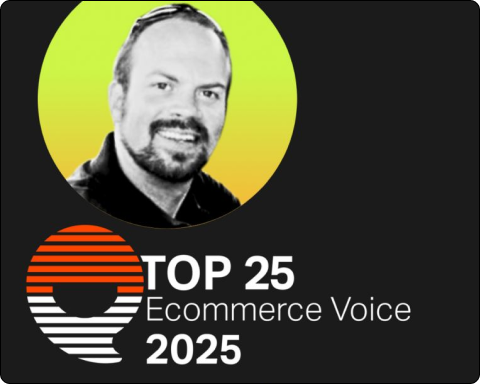Welcome back!
This is the second in our series of exclusive interviews with eCommerce leaders who are driving industry change and redefining the way we shop. They’re part of a new movement that’s breaking free from the old ways of doing business: swapping acquisition and never-ending product choice for on-site customer experience, informed by intent.
This shift reflects a deeper understanding happening across the industry, one that prioritises understanding the customers needs. So how do brands help customers on their shopping mission and what’s the right way to measure eCommerce success?
This week we were lucky enough to grab some time with Invisible Stuff’s Founder & CPO, Sienne Veit, for an eye opening conversation about the new intent metrics that actually move the needle. Alongside our CEO and founder, Warren Cowan, Sienne broke down consumer behaviour, the metrics that really matter and how brands should read these to boost sales. Intrigued? Dive into our Q&A below.
About Sienne
Sienne has more than two decades of product and tech experience under her belt, having made a name for herself leading digital transformation across global retail and technology brands. In her own words, she’s at her best when faced with the challenge of “untangling a complex web of platforms, people and processes” – something all retailers are trying to do.
Sienne is one of the leading eCommerce professionals redefining the industry by understanding customer intent and placing it at the heart of the consumer journey. With deep expertise in mobile apps, AI-driven personalisation, cloud technologies and omnichannel strategies, she’s creating seamless, intent-led shopping experiences that drive real, sustainable growth.
The Q&A
Warren: Let’s talk eCommerce metrics. Are conversion metrics helpful at all?
Sienne: Conversion is not useful for most teams. It doesn’t tell you about customer intent or the research and purchase cycle. And different products have very different journeys: if a customer is buying a whole kitchen at B&Q, for example, that’s going to be a very long journey of thinking, dreaming, planning and costing. So a kitchen retailer could have lots of website traffic over a six-month period that doesn’t result in any orders because customers are still in the dreaming and planning stage. And then when they finally decide to buy they may make their purchase in-store. Conversion metrics ignore all these stages of researching and choosing – stages that are vital to better learn about customer needs and where your offering might be putting people off.
What teams need are journey-based metrics. You should be getting data from every step of the customer journey, looking at the time customers spend on pages and where and when they’re dropping off. Honing in on customer journey failures can show you which fixes you need to make and whether they need urgent attention or a longer-term solution.
We know that CEOs and CFOs like single metrics. But I would hazard that just looking at your conversion rate and seeing if it’s going up or down is going to lead to a false sense of security because conversion is a lag metric. By the time you look at your conversion rate, you’ve already lost revenue and it’s too late. But lead metrics – measurements that help you really understand your sources, quality of traffic, how many people are going to hit a product page – are going to tell you more about your future health and revenue potential than conversion ever will. End of rant!
W: You’re preaching to the choir. So if conversion is a bad metric, what other measurements, beyond the ones you’ve just described, should businesses be looking at?
S: If CEOs want a single metric, a much better one is customer lifetime value – all good metrics are things that can continually improve.
What businesses need to do is constantly understand who are their best customers, how can they get more customers like them and what is it that really delights them. Your best customers are the ones who would buy anything you sell – so what specific strategies and tactics do you have to take any customer and turn them into the best? This could include getting people to shop across more of your assortment, moving them to higher value items or getting people to add more things into their basket through bundling products. There’s a whole range of things brands can do.
W: That delight you mention – that’s the tipping point. What would you say are the metrics that tell a business they’re giving people the right experience?
S: Look at customer behaviour on your product page – a customer who gets to the things that you sell and stays there for longer than two seconds is a good customer. Good customers are those who stay for any duration on a product page and they get better if they engage with product content or click on more than one image. You want people to be looking at size guides, how to’s, PDFs, reviews or other information you’ve got on your product detail page.
A great action is if customers ‘add to basket’ – though that doesn’t mean they’re necessarily going to checkout online. Adding to wish lists or bookmarks are also great customer actions; less great but still positive actions include copying and pasting the URL, product detail or product descriptor. Actions are good because they’re an indicator of some kind of intent and engagement. And if you understand actions you can start dismantling purchase barriers: if a customer is copying the product descriptor to search for a better price, you can defend against this.
People who look at FAQs and PDFs are people who can’t find information on your product detail page, but they’re still curious. This is good – you can redesign for that. People who add to wish lists, bookmarks or favourite something – they’re in a consideration cycle and it’s your job to figure out where they are in that. You can nudge them by driving them to a store, for example, or if it’s a complex purchase, with an offer.
W: What other metrics can we be tracking to see how we drive exploration?
S: For customers who bounce immediately, you could track if you see them again. Do they come back anywhere, or just bounce out back to Google? Where did they go back to? If they go from a product page to somewhere else on your site, you’re still part of the answer to whatever problem they’re trying to solve. They’ve figured out Google didn’t get it right but they themselves might be able to and there’s opportunity here for cross-sells, upsells and recommendations.
There’s also a big difference in customer behaviour across different channels. Mobile customers are very distracted and shop with the least intent; sometimes they end up shopping only by accident. Whereas if you’re sitting at a desktop, you’re in the zone. You don’t go shopping at your desktop by accident. If you’re on a brand’s dedicated app, you’re the best kind of customer. But customers can flit between these channels.
All this data helps us build up a picture of a customer. Who are they, what are they doing and how can I make their experience better? Am I dealing with someone with very low purchase intent, or much higher intent, and is there any way I can learn from this experience to turn this intent into a sale?
W: You mentioned wish lists earlier as a ‘great’ customer action – I’m curious about the penetration and adoption of wish lists?
S: It’s low penetration but extremely valuable data because even if customers have low purchase intent, you know what their consideration criteria are. And wish lists can be an indicator of future intent. The goal is to get people into the habit of adding things to their wish list.
W: Do you see people adding to cart a lot of the time as a placeholder?
S: Yes. The basket often acts as a number of things – that’s why it’s not always a signal of intent. It can be used as a calculator: people working out how much everything costs, including delivery. They may also use it to save products for later but that can create problems for businesses if a basket decrements stock. That’s why brands develop ‘save for later’ tools to help customers while sidestepping this issue.
W: If I can steer the conversation in a slight negative direction – one thing I’m really interested in is how you identify struggle. How do you identify customer friction?
S: Anytime a customer does something more than once or twice – that’s a point of struggle. If a customer is going back and forth filtering in different ways, you know there’s something wrong with your filters. Here’s someone who’s desperately trying to find something – they haven’t bounced off – and you’re in their way. Or if someone goes to a product page, looks at the picture, scrolls all the way to the bottom of a page then scrolls back up and starts filtering again, you know something’s wrong on that page or they didn’t find the information they needed. If someone adds things to their basket and hits a certain point – usually delivery and the length of time it takes – and then stops, you know there’s an issue. If a customer gets to a Product Listing Page and they don’t scroll or filter, you know something has put them off. They weren’t expecting this type or quantity of result from their search. But knowing these failure points is good because once you understand them you can fix them.
Remember you don’t have a lot of time with each customer. You’ve got maybe eight seconds where you’ve got to try and get them to do the next thing: filter, scroll, click onto something. There’s also a maximum number of pages a customer will consume – usually about five and a maximum of 13, if you have a customer with really high purchase intent.
W: Are there other ways retailers can better understand those failure points and customer needs?
S: Even if you’ve got great data science and data analysts, you should really spend some time with the people who know the customer journey. That could be your store staff, your commercial teams – any number of people who know and care about that customer journey. Watching session replays and engaging with real customers gives you so many ‘aha’ moments.
W: Can I ask you a slightly open ended question about how you see the eCommerce interface evolving in the future? Do you think there’s a different type of buying experience to put in front of the customers?
S: Social media has helped evolve the way we shop: if you put anything in front of me, as a customer, I should be able to shop it. I see it, I want it. Let me buy it right there and then with as little friction as possible.
And I think what we’re starting to see now with some of the new AI tooling are purchase experiences that are more conversational and less transactional. Something that invites the customer to participate – not guided selling or some kind of chatbot, but something a little more modern and slick.
Embracing journey-based metrics
It’s time to stop relying on simple conversion rates. Instead, brands should be gathering granular, journey-based metrics to build a clearer picture of customers and, crucially, their purchase intent. Intent-led Commerce is the future of online retail – allowing brands to better delight their users and quickly break down any barriers getting in their way.
eCommerce nirvana won’t be found by obsessing over conversion rates: it’s attained through truly knowing your consumers and understanding customer lifetime value.



